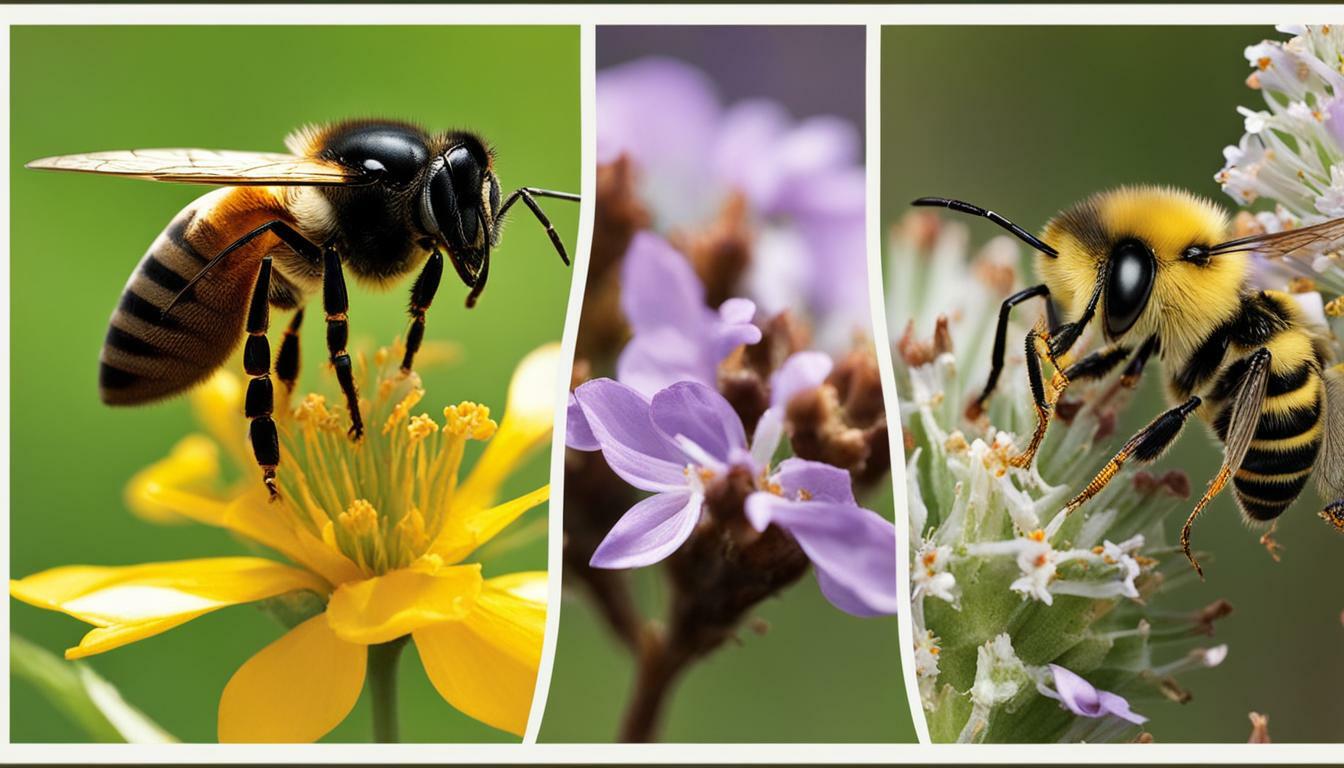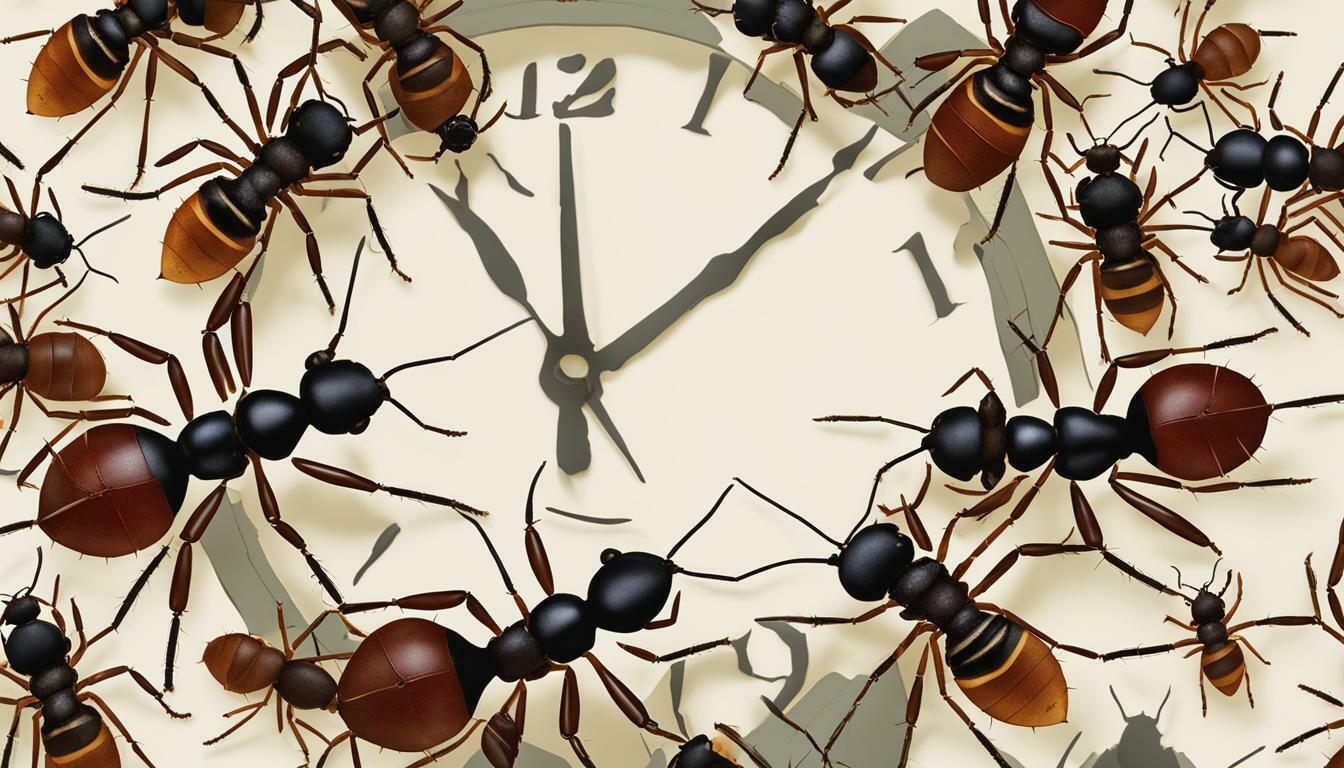When it comes to stinging insects, hornets and yellowjackets are often confused with one another. Both of these insects belong to the wasp family and share many similarities with other species. However, there are some key differences that set them apart.
In this section, we will explore the unique characteristics of hornets and yellowjackets and compare them to other wasp species. By the end of this section, you will have a better understanding of how to differentiate between these two insects.
Key Takeaways:
- Hornets and yellowjackets belong to the wasp family.
- There are distinct differences between hornets and yellowjackets.
- Understanding the differences can help with identification and potential risks.
Hornet Identification
It’s always important to be able to identify the creatures around us, and hornets are no exception. Here are some key features that can help you identify hornets:
| Physical Characteristics | Behavior | Nesting Habits |
|---|---|---|
|
|
|
Fun fact: Hornet venom contains a chemical called acetylcholine, which can cause pain, itching, and swelling. However, some people actually use hornet venom as a natural pain reliever for conditions like arthritis and rheumatism.
By understanding the unique characteristics of hornets, you can better identify them and take appropriate precautions to avoid any potential conflicts with these fascinating insects.
Yellowjacket Identification
Yellowjackets are members of the wasp family, and they can be easily identified by their distinctive black and yellow striped bodies. Unlike other similar-looking species, yellowjackets have relatively slender waists and are around half an inch to an inch long.
In terms of behavior, yellowjackets are social insects that live in colonies ranging from a few dozen to several thousand individuals. They are most active during the summer months and can be found in various habitats, including gardens, woodlands, and urban areas.
| Physical Characteristics | Behavior and Nesting Habits |
|---|---|
| Black and yellow striped bodies | Social insects that live in colonies |
| Slender waist | Most active in the summer months |
| Half an inch to an inch long | Found in various habitats |
Yellowjackets are known for their aggressive behavior and can be a nuisance to humans, especially in outdoor settings. They are attracted to sugary foods and will often scavenge for food in trash cans and picnic areas. In some cases, yellowjackets may become territorial and sting humans in self-defense, which can cause severe allergic reactions in some individuals.
By understanding the physical characteristics and behavior of yellowjackets, you can take steps to avoid encounters with them and minimize the risk of getting stung.
Comparing Hornets and Yellowjackets
Despite their distinct differences, hornets and yellowjackets share some characteristics:
- Social structure: Both hornets and yellowjackets live in colonies and have a hierarchical social structure. They work together to build nests, gather food, and care for their young.
- Stinging capabilities: Both hornets and yellowjackets have stingers that they use for defense and hunting. Their stings can be painful and in rare cases, cause severe allergic reactions.
- Diet: Hornets and yellowjackets both feed on nectar, but they also prey on other insects, such as flies and spiders, to feed their young.
It’s important to note that while there are similarities between these two species, it’s still essential to be able to tell them apart. Both hornets and yellowjackets can be aggressive if they feel threatened, and it’s best to avoid getting too close to their nests or disturbing them.
Hornet Sting vs Yellowjacket Sting
One of the most important differences between hornets and yellowjackets lies in their stinging abilities. Both insects are known for their painful stings, but there are some key differences to be aware of.
Hornet Sting
Hornet stings are typically more painful than yellowjacket stings. In fact, they are considered one of the most painful insect stings in the world. Hornets are known to sting repeatedly, so if you encounter one, it’s important to move away quickly to avoid being stung multiple times. In addition to the initial pain, hornet stings can also cause swelling, redness, and itching at the site of the sting.
If you are allergic to hornet stings, the reaction can be even more severe. Symptoms of an allergic reaction to a hornet sting can include difficulty breathing, hives, and swelling of the face, throat, or tongue. In severe cases, anaphylaxis may occur, which can be life-threatening if not treated immediately.
Yellowjacket Sting
Yellowjacket stings are also painful, but they are typically less painful than hornet stings. Yellowjackets can also sting repeatedly, so it’s important to move away quickly if you encounter them. Yellowjacket stings can cause swelling, redness, and itching at the site of the sting. In some cases, they may also cause a localized allergic reaction, which can be treated with over-the-counter antihistamines.
While yellowjackets can also cause anaphylaxis in rare cases, it is less common than with hornet stings. If you are allergic to yellowjacket stings, it’s important to seek medical attention right away if you experience any symptoms of an allergic reaction.
Overall, both hornets and yellowjackets can pose a risk to humans, especially for those who are allergic to their stings. It’s important to take precautions when encountering these insects, such as avoiding swatting at them or disturbing their nests. If you do get stung, it’s important to monitor your symptoms and seek medical attention if necessary.
Conclusion
Through this article, we have learned about the key differences between hornets and yellowjackets. From their physical characteristics to their behaviors and nesting habits, we have explored the unique features that distinguish these stinging insects.
Identifying hornets and yellowjackets can help us better understand the risks they may pose and how to coexist with them more harmoniously. By appreciating their commonalities and differences, we can appreciate the fascinating world of these insects.
Remember, if you encounter a hornet or yellowjacket, try to remain calm and avoid disturbing their nest. If you are stung, seek medical attention if necessary. With proper knowledge and caution, we can learn to live alongside these insects and appreciate the important role they play in our ecosystem.
FAQ
Q: What is the difference between hornets and yellowjackets?
A: Hornets and yellowjackets are two distinct species of wasps. While they share similarities, such as their social structure and stinging capabilities, they differ in physical appearance, nesting habits, and behavior.
Q: How can I identify a hornet?
A: Hornets can be identified by their large size, typically ranging from 0.8 to 2 inches in length. They have a brown or black body with yellow or white markings. Hornets also have a smooth stinger and build their nests in aerial locations.
Q: How can I identify a yellowjacket?
A: Yellowjackets are smaller than hornets, typically measuring around 0.5 to 0.75 inches in length. They have bright yellow and black markings on their bodies. Yellowjackets have a jagged stinger and build their nests in various locations, including underground and in wall voids.
Q: What similarities do hornets and yellowjackets have?
A: Both hornets and yellowjackets exhibit a social structure, with colonies consisting of a queen, female workers, and male drones. They also possess a powerful sting and can be aggressive when their nest is threatened.
Q: How does a hornet sting compare to a yellowjacket sting?
A: Hornet stings tend to be more painful than yellowjacket stings. Furthermore, hornets can sting repeatedly without losing their stinger, while yellowjackets can only sting once before losing their stinger. The severity of reactions and potential allergenic properties can vary for each individual.
 Skip to main content
Skip to main content


